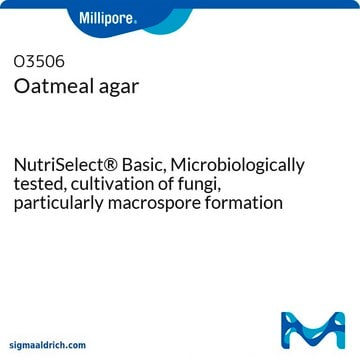70139
Potato Dextrose Agar
NutriSelect® Plus, suitable for microbiology
Synonym(s):
PDA, Potato Glucose Agar, Potato Glucose Agar
About This Item
Recommended Products
Agency
APHA
USP
Quality Level
reg. compliance
FDA
sterility
non-sterile
form
powder
shelf life
limited shelf life, expiry date on the label
composition
agar, 15 g/L
dextrose, 20 g/L
potato extract, 4 g/L
packaging
pkg of 100 g
pkg of 2.5 kg
pkg of 500 g
manufacturer/tradename
NutriSelect® Plus
technique(s)
microbiological culture: suitable
color
light yellow
final pH
5.6±0.2 (25 °C)
application(s)
agriculture
bioburden testing
environmental
food and beverages
microbiology
suitability
nonselective for Aspergillus spp.
nonselective for Candida spp.
nonselective for Penicillium spp.
nonselective for Pichia spp.
nonselective for Saccharomyces spp.
nonselective for Zygosaccharomyces spp.
nonselective for molds (General Media)
nonselective for yeasts (General Media)
Looking for similar products? Visit Product Comparison Guide
General description
Application
Features and Benefits
- Quality control with growth promotion test according to industry standards
- Quality assurance acc. to ISO 9001
- Cost-efficient powdered media
Preparation Note
Other Notes
Footnote
The designations basic, plus, or prime are added to indicate the quality control level, from basic quality control to standard QC plus to prime for full regulatory compliance.
Legal Information
Storage Class Code
11 - Combustible Solids
WGK
WGK 3
Flash Point(F)
Not applicable
Flash Point(C)
Not applicable
Personal Protective Equipment
Choose from one of the most recent versions:
Already Own This Product?
Find documentation for the products that you have recently purchased in the Document Library.
Customers Also Viewed
Our team of scientists has experience in all areas of research including Life Science, Material Science, Chemical Synthesis, Chromatography, Analytical and many others.
Contact Technical Service










